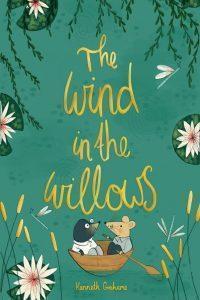“The Mole had been working very hard all the morning, spring-cleaning his little home. First with brooms, then with dusters; then on ladders and steps and chairs, with a brush and a pail of whitewash; till he had dust in his throat and eyes, and splashes of whitewash all over his black fur, and an aching back and weary arms.”
This was one of the first-ever children’s books of the twentieth century. The Wind in the Willows was Kenneth Grahame’s penultimate novel and by far his most popular. Published in 1908, it was the last book he released before his death in 1932. It’s a lighthearted tale of animals and adventure; enjoyed by generation after generation.
Although numerous publishers initially rejected the novel, it was highly successful once released. US President Theodore Roosevelt, in particular, was a huge fan of its inventive characters. It’s made up of one main story along with numerous short stories featuring Rat and Mole.
Summary
The book follows four anthropomorphised animals; Rat, Mole, Toad, and Badger. It begins with Mole meeting Rat for the first time, and their friendship soon blossoms. They meet Toad, a cheerful but arrogant amphibian, and Badger, a well-respected but reclusive wood dweller. The group have many adventures together, hitchhiking across railroads, and reclaiming what is theirs. It’s a simple tale full of childish wonder and dramatic consequences, perfect for younger readers.
Commentary
The Wind in the Willows is the ideal book for young children but leaves much to be desired for older readers.
It’s a didactic tale. The characters make mistakes and have to face the consequences. They listen to each other and learn from their failures. It’s a vital lesson that children must learn at a young age, and this collection of short stories facilitates that. The book covers a wide variety of genres. It shows the endearing side of true friendship between Rat and Mole. Hilarious plot twists ensure that the novel remains entertaining. But there are also darker stories of loss and betrayal to keep readers interested.
The characters are as realistic as animals can be. They all make mistakes, they don’t always win, and each character has flaws. They develop over the course of The Wind in the Willows and are changed when they return home. Mole grows to enjoy adventures, while Rat becomes more set in his ways. However, the characters are highly stereotypical of children’s books. Mole is the ‘everyman’, a happy-go-lucky hero. Ratty is the inventor, the free-spirited imaginative friend. Toad is unreliable and arrogant, but a keen adventurer. Finally, Badger is the wise old mentor, the voice of reason.
There’s not a single main female or person of colour character in the entire book. The four protagonists represent the white British male and leave no room for anyone else. Yes, the characters are animals, but the symbolism isn’t even lost on children as to who they’re meant to be. As well as this, for anyone over the age of ten, it isn’t very interesting. The characters are somewhat flat and the plot lines are dull. The background also doesn’t make much sense; why are some animals wild but others not? It leaves the reader with a lot of unanswered questions.
Recommendations
Overall, I’d give Kenneth Grahame’s The Wind in the Willows a one out of five. It’s a great tale for children, but not that intriguing for adults. I’d recommend it for toddlers and young children, but not for teens or older.

Want to read it for yourself? You can find it in:
Prefer to listen to it instead? You can find it on:
Find me on Goodreads or StoryGraph!
